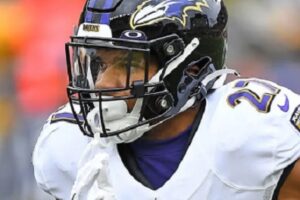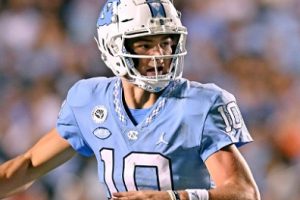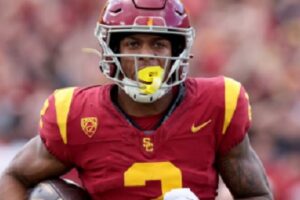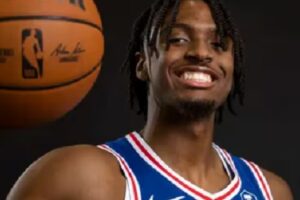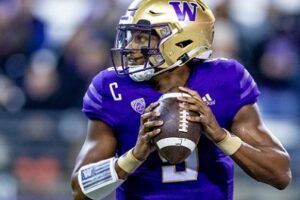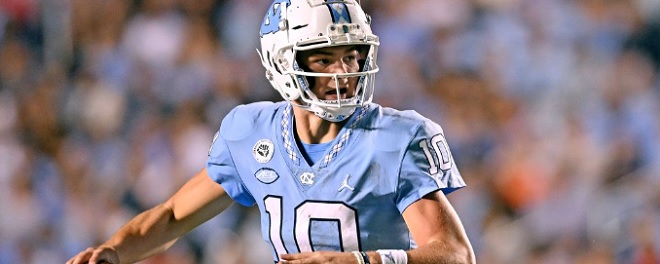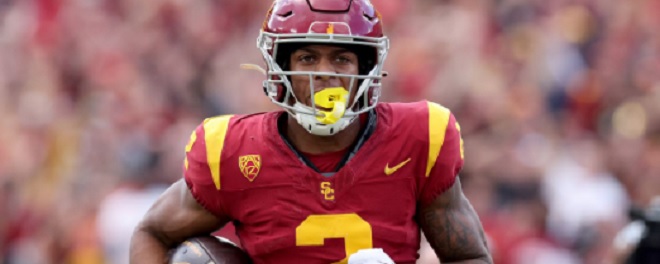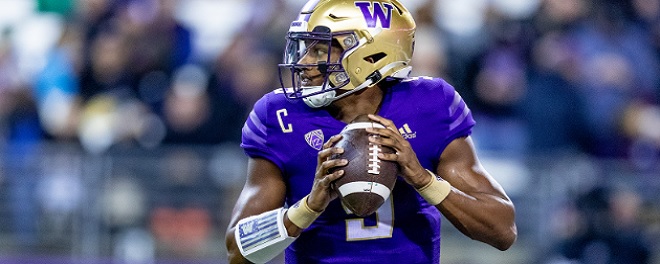By Charlie Campbell.
Send Charlie an e-mail here: [email protected]
Follow Charlie on Twitter @draftcampbell for updates.
This page was last updated April 17, 2013. Follow me @walterfootball for updates.
Position Review: Guards
Guard Class
Early-round talent: A
Mid-round: B+
Late-round: C+
Overall grade: A-
2012 prospects vs 2013
David DeCastro < Jonathan Cooper
Kevin Zeitler < Chance Warmack
Amini Silatolu < Larry Warford
Jeff Allen < Dallas Thomas
Kelechi Osemele > Alvin Bailey
Josh LeRibeus < Brian Winters
Brandon Brooks > Hugh Thornton
Tony Bergstrom > Garrett Gilkey
Guard is one of the strongest positions in the 2013 NFL Draft class. There is rare, once-in-a-decade elite talent for Round 1 as well as good players for the second day of the 2013 NFL Draft. There are pundits who believe that Warmack is the best overall prospect this year Cooper is viewed as a sure-fire first-rounder who could go ahead of Warmack, and it wouldn’t be a complete shock if Warford is selected as a late first-rounder.
If you were to merge the two classes, Cooper would still be the top prospect even though I really liked DeCastro last year. The 2012 NFL Draft class was much more talented than 2013 overall, but Cooper and Warmack could be selected in the top 20 while DeCastro went 24th overall. I think all three grade out roughly the same and each offers a different flavor for an offense.
Even though Warford might not go in the first round like Zeitler did, in my opinion, Warford is the better prospect. Warford would be a the first-rated guard and a late first-rounder in most drafts. I would put Zeitler and Silatolu ahead of Dallas Thomas. I really liked Osemele last year as well. I would rate him on Thomas’ level. Jeff Allen should not have been drafted ahead of Osemele, but that is one reason why the Chiefs have the first-overall pick and the Ravens are picking at No. 32.
LeRibeus, Brooks, Bergstrom would go behind Winters but ahead of Thornton and Gilkey. The guard position is even stronger if you include a group of tackles and centers who could be moved inside to guard in the NFL. That group includes: Florida State’s Menelik Watson, Oregon’s Kyle Long, Syracuse’s Justin Pugh, Alabama’s Barrett Jones, Wisconsin’s Travis Frederick and Arkansas Pine-Bluff’s Terron Armstead. The 2013 NFL Draft has a rare group of guard talent.
Safest Pick: Chance Warmack, Alabama

You really can’t go wrong picking Jonathan Cooper or Chance Warmack. Both are extremely safe selections. Warmack looks like a Day-1 starter and future Pro Bowler. He should play immediately and become of the top guards in the NFL over the next decade. Warmack is a dominant run-blocker who is rock solid in pass protection. He has a proven body of work against elite talent the past three seasons. It would be utterly shocking if Warmack didn’t pan out as a professional.
Biggest Bust Potential: Brian Winters, Kent State

It isn’t all that fair to pick Winters considering he probably won’t go in the first two rounds. The reason why Winters is the selection is because he struggled at the Senior Bowl. Winters had issues in the one-on-ones in pass protection, and that is worrisome considering he played his college football against weak competition.
Winters (6-4 320) was a tackle in college and clearly is a guard because of his short arms (32 3/4) and concern about his ability to handle speed-rushers at the next level. Winters is probably going to need some work at the NFL level before he can attempt to contend as a starter.
Guard Rankings by Attributes
Pass Protection:
NFL prototype: Jahri Evans, Saints
- Jonathan Cooper
- Chance Warmack
- Dallas Thomas
- Larry Warford
- Alvin Bailey
- Brian Winters
- Garrett Gilkey
- Hugh Thornton
Recap: The NFL is a passing-driven league, so keeping a clean pocket as a pass-blocker is the attribute that the majority of teams consider first. Coaches want the guards to keep defensive tackles from gaining penetration or causing disruption. If the guards are successful, quarterbacks can step up in the pocket to avoid edge-rushers. This helps out the offensive tackles significantly. Plus, good guard play provides better throwing lanes for the quarterback. This is why the Saints are one team that invests in guards instead of tackles.
Cooper is extremely quick and athletic. He was a great pass-blocker in college and that should be his biggest strength in the NFL. Speed-rushers are nullified by Cooper. He also has a heavy base to anchor against heavy bull rushers. Cooper’s strength, speed and athleticism allow him negate whatever is thrown at him.
Warmack is superb in pass protection. The only sack I remember him allowing as a senior was in the SEC Championship Game to John Jenkins. Warmack spent the last few years as a tremendous pass-blocker who kept pressure off his quarterback and allowed him room to operate.
Thomas is a very good pass-protector, which is his best trait. He did well as a tackle in 2011 and was superb as a senior protecting Tyler Bray.
Warford would be at or near the top in every category in many draft classes. He was a great pass-blocker in 2012. Warford completely shut down Missouri speed-rusher Sheldon Richardson. Warford also did well against Florida’s Sharrif Floyd and held his ground against the powerful Jenkins. Warford continued to do well against Jenkins at the Senior Bowl. Warford really had a great week in Mobile in the pass protection one-on-ones.
There is a big drop off after Warford; Bailey looked better as a pass-blocker in his sophomore season. However, Bailey has the potential to be a good protector in the NFL.
Winters played tackle in college and could develop into a reliable pass-protector in the NFL at guard. However, he needs time and patience for growth. Winters struggled at the Senior Bowl.
Gilkey is going to need developmental time in pass protection. He is going to see a huge difference in talent coming from Chadron State to the NFL. Thornton had a lot of problems in Mobile. He is extremely strong with some athleticism, but looks like a project in the NFL.
Run Blocking:
NFL prototype: Mike Iupati, 49ers
- Chance Warmack
- Larry Warford
- Jonathan Cooper
- Dallas Thomas
- Brian Winters
- Alvin Bailey
- Hugh Thornton
- Garrett Gilkey
Recap: Guards are the engine of a good running game. They are the most important blockers for opening holes up the middle in addition to pulling or moving on stretch runs. Dominant guards who can open up holes even when defenses know the run is coming provide a mental edge, especially late in games.
Once again, Warmack is the best blocker in this draft class. He is pure road grader on the ground. He was Alabama’s best run-blocker to open holes for Trent Richardson, Eddie Lacy and the team’s other backs. Warmack has the power to push defensive tackles out of their gap with the speed and athleticism to hit blocks on the move. He opens up lanes on the second level as well. Warmack’s run blocking should be an asset from his first day.
Warford is a phenomenal run-blocker in his own right. The 333-pounder can blast defensive linemen off the ball. He also is quick enough to hit blocks on the second level. Warford is extremely physical and blocks with a mean streak. He’ll be a good run-blocker in the NFL.
Cooper has his weight up to 311 pounds, which will help his run blocking in the NFL. He was a good run-blocker in college, but mainly won based off his speed and athleticism to beat defenders to a spot and get on them in an instant.
Winters has the potential to be a solid run-blocker in the NFL, and his increased weight should help him. It wouldn’t be surprising if his run blocking comes along faster than his pass protection.
Bailey was a quality run-blocker in college. He could use a little more power to push linemen off the ball in the NFL.
Thornton (6-3, 320) and Gilkey (6-5, 319) are very powerfully built, so they both could become good run-blockers in the NFL. Entering the next level, their run blocking is ahead of their pass protection.
Speed:
NFL prototype: Jahri Evans, Saints
- Jonathan Cooper
- Chance Warmack
- Dallas Thomas
- Larry Warford
- Alvin Bailey
- Brian Winters
- Hugh Thornton
- Garrett Gilkey
Recap: Speed helps guards to hit blocks on the second level and while pulling. Zone-blocking schemes require their guards to have good quickness to set up their runs.
Cooper is the fastest guard in the 2013 NFL Draft. He fires out of his stance and gets on defenders before they’re ready. Cooper uses his speed to win at the second level. He is extremely skilled at hitting blocks in space due to how fast he is and his athletic ability. Cooper could be one of the fastest interior linemen in the NFL during his career.
Warmack would be the fastest prospect in most years. He is quick to the second level, and his speed is such a weapon in coordination with his power. Warmack’s quickness is a definite part of his great skill set.
Even though Warford weighs 333 pounds, he is surprisingly quick for such a large blocker. Warford can get to linebackers on the second level and also has the speed to pull. His short-area quickness is very impressive.
Thomas is a fast lineman, but he doesn’t seem to have as much explosion as the top three. Thomas would be rated higher in a typical draft class. The same goes for Bailey, who has good speed and athleticism.
Even though Winterss has to move inside, he could have the quickness for guard in the NFL. It is hard to estimate given his level of competition.
Thornton seems to have heavy feet and doesn’t move around that well. Gilkey needs to improve on his speed for the next level.
Strength:
NFL prototype: Carl Nicks, Buccaneers
- Chance Warmack
- Larry Warford
- Jonathan Cooper
- Hugh Thornton
- Alvin Bailey
- Garrett Gilkey
- Dallas Thomas
- Brian Winters
Recap: There is no substitute for power at the point of attack. All of the top guards in the NFL have it. The strength to push linemen out of their gap results in positive yards on the vast majority of plays.
Warmack is the most powerful guard in this draft class even though others weigh more. He is so strong that when he gets his hands on linemen, they are done. Warmack uses his strength to sustain his blocks as long as he deems acceptable. He can push linemen around and toss them aside. Warmack’s power allows him to bully linebackers and defensive backs. He has great football functional strength.
Warford isn’t far behind. He can blast open holes with his power and pushes defenders around at the point of attack. Warford’s size and strength will make him an asset for short-yardage situations in the NFL.
Cooper has shown that he has power for the NFL. He put that on display at the Combine. He also has big upside to develop more power in the years to come. Other guards will probably top him in the bench press, but the projection for the future favors Cooper and his potential.
Thornton (6-3, 320) is built like a tank. He has serious upper body strength, so if he develops his other skills alongside that power, he could turn into something.
Bailey showed some power as a blocker during his sophomore season. Gilkey has size to him, but he could use some time refining in an NFL strength and conditioning program.
Thomas (6-5, 306) is a little light and probably should add more powerful bulk for the NFL. Winters had a bad Combine with only nine reps on the bench press. He must get stronger for the NFL.
Zone Blocking:
NFL prototype: Wade Smith, Texans
- Jonathan Cooper
- Chance Warmack
- Dallas Thomas
- Alvin Bailey
- Larry Warford
- Brian Winters
- Garrett Gilkey
- Hugh Thornton
Recap: The zone-blocking system is run by a number of NFL teams, and the success of the scheme has many power-man teams adding some zone plays into the playbook. The zone scheme calls for guards to have the ability to move well laterally and downfield to help set up moving wall with cut-back lanes. Guards need the athleticism and quickness in order to be effective.
Cooper is a perfect fit in a zone-blocking scheme. He is so fast and athletic; he could play center or guard for a zone team. Cooper is a rare guard who could be a prototypical interior blocker for a zone team.
Most years there isn’t a guard like Cooper, so Warmack would be rated first in this as well – if Cooper weren’t in the class. Warmack has the quickness and agility to be excellent in a zone scheme. Alabama ran some zone plays, and of course, Warmack did well in them.
Thomas and Bailey both have the speed and athleticism to be good fits in a zone system. They probably would be better off in a zone scheme as professionals.
Even though Warford isn’t a natural fit as a zone player, I think he has enough quickness and agility to pull it off. Winters could play in a zone scheme at guard, which could be a good fit for him.
Thornton has heavy feet, and Gilkey may not quick enough for a zone system.
Power Man:
NFL prototype: Marshall Yanda, Ravens
- Chance Warmack
- Larry Warford
- Jonathan Cooper
- Dallas Thomas
- Alvin Bailey
- Brian Winters
- Hugh Thornton
- Garrett Gilkey
Recap: A lot of teams in the NFL run a power man-blocking scheme. Guards for this scheme need the ability to defeat their defender to blast open or seal a running lane. Guards need to have the power to move defenders and sustain blocks.
Warmack is the prototypical guard for a power-man team. He does everything coaches could ask with his ability to be a bulldozer in the run game. Warmack can push defenders all over the field and get out to hit blocks on linebackers. He is a perfect fit for a power-man offense.
Warford isn’t that far behind him. Warford is superb at the point of attack. He uses his power to push defenders out of their gap. Warford excelled in a power-man scheme in college and should continue to do that in the NFL.
Cooper is a little different from the other two, but he played power man in college and was very good. Cooper doesn’t quite pack the punch of Warmack or Warford, which is why those two are rated ahead of him. However, Cooper will be excellent in any scheme.
Thomas did well in a power-man scheme in the past, but he could use more bulk to move defenders around in the NFL. Bailey and Winters should both be able to play in an NFL man system.
Thornton has to play in a power scheme. That would be the best fit for his significant upper body strength. Gilkey also is better for a man system.
Versatility:
NFL prototype: Logan Mankins, Patriots
- Jonathan Cooper
- Dallas Thomas
- Chance Warmack
- Brian Winters
- Alvin Bailey
- Larry Warford
- Hugh Thornton
- Garrett Gilkey
Recap: A lot of NFL offensive line coaches want to crosstrain their interior linemen for another position, especially among the backup offensive linemen. It helps teams in making the decision on who to keep active on game days. Linemen who can play more than one position are highly valued. Coaches like guards who can play center or tackle if there is an injury in the middle of a game.
Cooper’s speed and athleticism leave him looking the most versatile. He could be a future pro bowler at guard or center.
Thomas played tackle and guard for Tennessee. He could get consideration in the NFL as a center if he doesn’t add weight. If Thomas doesn’t win a starting spot as a rookie, he should be a valuable swing backup on game days.
Warmack probably has the ability to play center if it is absolutely necessary, but he’s so dominant at guard, I wouldn’t expect to see him getting a look at another position.
Winters played tackle in college, so he could maybe move outside in a pinch, but would probably need double-team help on edge-rushers. Bailey has played guard, but it wouldn’t surprise me if his NFL team crosstrains him at center.
Warford, Thornton and Gilkey don’t look like candidates to play anything other than guard. Gilkey played tackle in college, but his arms are way too short to play tackle in the NFL (31 3/4 inches).
Pulling:
NFL prototype: Ben Grubbs, Saints
- Jonathan Cooper
- Chance Warmack
- Larry Warford
- Dallas Thomas
- Alvin Bailey
- Hugh Thornton
- Garrett Gilkey
- Brian Winters
Recap: Pulling is absolutely necessary for a man-blocking system to work. Zone teams are becoming more diverse and are mixing in more power-man plays that have guards pulling. The quick and athletic guards of zone schemes do better pulling than isolating and charging straight ahead. Thus, a zone team will like to see a prospect’s ability to pull as well.
Cooper is awesome at pulling. He is so fast looping around to hit blockers; there is no doubt he’ll execute this well in the NFL. Cooper regularly beats defenders to spots. He stays on his feet and often rocks linebackers and defensive backs downfield. Long-time NFL assistant, and Cooper’s college coach, John Shoop told WalterFootball.com that Cooper is the best pulling guard he’s ever been around in his coaching career.
Warmack is fantastic at pulling. Alabama had a ton of success on running plays where Warmack pulled around to the right side. He is so powerful and quick that when he gets moving he charges through defenders to create massive holes. Warmack should be an high-impact puller from his first day in the league.
Warford isn’t as fast as Warmack or Cooper, but Warford could pack the biggest punch as a pulling guard. He should be good at it in the NFL.
Thomas has the athletic ability and quickness to do well when he pulls. Thomas could use a little more force, but he should improve this skill in the NFL.
Bailey also projects to be solid in this area. Thornton, Gilkey and Winters need work to become more effective at pulling.
|
|
2024 NFL Mock Draft - April 16
NFL Power Rankings - Feb. 22
Fantasy Football Rankings - Feb. 19
NFL Picks - Feb. 12

